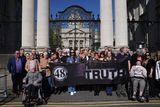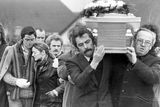Chilling handwritten notes that show twisted mind of Malcolm Macarthur
APIECE of paper in Malcolm Macarthur's handwriting, found after his arrest in August 1982, showed that he was actively considering the murder of his mother, Irene, at her home near Trim in Co Meath.
Macarthur was also suspected of having killed his own father as well nurse Bridie Gargan and farmer Tom Dunne. It is known that Macarthur harboured deep feelings about his parents.
He was regularly beaten by his father Danny who virtually abandoned him as a child.
Danny Macarthur died in what are now considered suspicious circumstances on the night that Malcolm made a rare visit to the family farm in Co Meath. It was believed at the time that Mr Macarthur senior had died of natural causes in his sleep.
No post-mortem was carried out, and after his father's death in the late Seventies, Macarthur received £70,000 from the estate which he squandered.
However, during their examination of Macarthur's background, detectives became suspicious about how his father died suddenly on Macarthur's first visit to the family home in several years.
It was when the inheritance money ran out that he began his killing spree, in a bizarre plot to fund his lifestyle through armed robbery.
Among Macarthur's belongings, after his arrest in August 1982, detectives discovered the notes showing he was planning to kill his mother and make the murder look like an accidentalelectrocution.
He wrote: "Electric fire with faulty plug attached. Adapter left in walls perhaps fused. Adapter plug pulled out. None of my fingerprints. Take away one of her fuses if it appears there are too many with and body of fire." (sic)
Several years ago, Mrs MacArthur moved away from the house in Co Meath, not far from her family's farm, which she had shared with her friend and former nursemaid to her son, Kate McCann.
Though it did not emerge at the time of his arrest and trial, detectives had clear suspicions about the plot to kill his mother. They were also concerned that he might have intended to kill his friend, Attorney General Paddy Connolly, in whose apartment he was arrested in August 1982.
It was these residual fears that caused prison authorities to decide against a full release for Macarthur, despite the fact he has been in Shelton Abbey minimum security prison in Co Wicklow for almost two years, and is regarded as a model prisoner.
Macarthur is also 60. He is one of a group of around 10 lifers in the prison system about whom there are continuing concerns.
A few, including the English serial rapists and killers, Geoffrey Shaw and John Evans, are expected never to be released. Shaw and Evans came to Ireland in 1976 with the intention of kidnapping, raping and murdering one young woman every week.
They had already kidnapped and murdered Mary Duffy, from Mayo, and Elizabeth Plunkett from Dublin when they were caught by gardai.
Shaw and Evans had almost certainly already carried out several rapes and were suspected of murdering another young woman in the north of England before coming to Ireland. It is believed that neither will be released until age and infirmity make them no further threat to women.
Despite having served 28 years in prison - both are still held in Castlerea Prison - Shaw and Evans are not the State's longest serving prisoners. That record goes to Jimmy Ennis who was sentenced to life imprisonment for killing a neighbour in 1964. He was released on parole in 1982 but carried out another serious assault on a woman which almost resulted in her death.
Ennis, now in his 70s, is no longer regarded as a serious threat to society but he says he is happy to stay in Shelton Abbey and is content to be allowed out for work during the week and equally happy to go back inside at night.
Another prisoner who will almost certainly never be released until age and infirmity overcome him is Tommy Murray from Co Galway. Murray first killed an elderly neighbour, William Mannion, in his home village of Ballygar in 1981, for which he received life imprisonment. Murray was only 17 at the time.
Despite objections from gardai and prison staff, Murray was released twice and killed twice. He was freed from prison in 1997 and murdered the Galway taxi driver, Eileen Costello-O'Shaughnessy. Murray was questioned at the time but was freed after people in his lodgings apparently gave him a satisfactory alibi. Mrs Costello-O'Shaughnessy's killer also drove from the scene in her taxi after dumping her body and it was not known how Murray could have been able to drive a car. It later emerged he had received driving lessons while awaiting release from prison.
Murray was returned to jail and, despite warnings from gardai that he constituted a grave danger, he was again released in 2000 and returned to Ballygar, where he killed his former primary school teacher, 80-year-old Nancy Nolan. Murray had no reason to resent Mrs Nolan but, over some imagined slight, he went to her house and beat her to death with a hammer.
The decision to release Murray was criticised in a report ordered by the then Minister for Justice and it is unlikely the mistake of releasing him will be made again.
There are another four prisoners who have served longer sentences than Malcolm Macarthur and they, too, continue to be held until the prison authorities are fully satisfied that they no longer present a danger to society.
Altogether there are 189 prisoners, including five women, who are serving life imprisonment on murder charges. Prison sources point out that there is a great disparity among the lifers.
Many are in prison as a result of domestic killings, most of which resulted from heightened passions or involved alcohol, and almost none of these is regarded as a threat to society.
Many figures involved in the penal system believe that it is cruel to detain most of these "ordinary" lifers for more than terms like seven years. Most agree, however, that there are a smaller number who need to be detained for the sake of society.
Join the Irish Independent WhatsApp channel
Stay up to date with all the latest news














